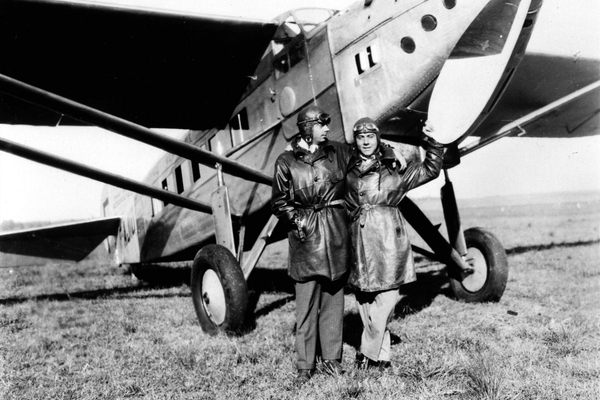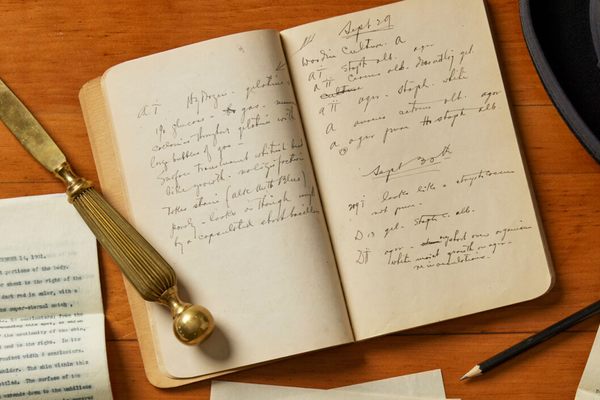One Man’s Quest to Restore the First-Ever Air Force One
President Dwight D. Eisenhower’s plane is starting to look like itself again.
It was 1953 and U.S. President-elect Dwight D. Eisenhower sat at a big mahogany desk working on a plan to end the Korean War. A small team of elite Washington staffers lounged nearby on mid-century leather sofas or in custom bucket chairs, smoking over hand-carved wood tables.
Eisenhower and his team weren’t at the White House, though, or even in D.C.: At that exact moment, they were soaring high over the Pacific Ocean in an overhauled 1948 Lockheed C-121 Constellation aircraft, the first-ever Air Force One.
The 100-foot-long and 132-foot-wide, four-propeller plane could hold about 16 passengers, was piloted by a crew of five, and staffed with two or three attendants. Its elegantly tapered fuselage was shaped like a bottlenose dolphin and had thousands of mirror-polished aluminum panels in addition to the hand-painted word “Columbine” arched above a blossoming blue and white flower.
“The Constellation was the most iconic of the 1950s airliners, and this one took things to a new level,” says military historian and writer Nicholas A. Veronico. “It was the first plane to go by the call sign, Air Force One, and was heralded as the star of the skies.”
Yet, 60 years later, the plane, known as Columbine II, lay neglected and rusting in a field at a rural Arizona airport. That is until aeronautical entrepreneur and aviation history buff Karl Stoltzfus discovered its pedigree and took it upon himself to restore the first Air Force One.

Columbine II spent the first five years of its life as a military-issue V.I.P. transport before Eisenhower ordered comprehensive upgrades, named it after the flower of his wife’s home state of Colorado, and made it his presidential plane in 1953. The Federal Aviation Administration adopted the tagline Air Force One a year later after a near-catastrophic incident over Richmond International Airport. The plane’s numerical, military tagline 8610 was identical to that of a commercial airliner seeking to land and confusion among air traffic controllers nearly caused a midair collision. From then on, presidential planes were known as Air Force One.
But Columbine II’s significance goes beyond being the first Air Force One: Eisenhower used the plane to usher in a new era of presidential diplomacy.
While Franklin D. Roosevelt was the first president to have an official plane, he used it just three times. His successor, Harry Truman, was similarly avoidant. However, Eisenhower was a seasoned pilot and relied heavily on air travel to manage Allied campaigns during World War II.
“He saw the potential of a presidential plane as a powerful tool for international and domestic relations,” says Veronico, author of Air Force One: The Aircraft of the Modern U.S. Presidency. Eisenhower traveled across the U.S. and the world to meet with leaders, logging more than 63,000 miles in the first two years of his presidency. He used Columbine II to end the Korean War and wrote his famed “Atoms for Peace” speech onboard. It helped Eisenhower “lay the foundation for how modern presidents conduct foreign diplomacy,” says Veronico.

Columbine II was later repurposed as a V.I.P. transport for Vice President Richard Nixon and visiting dignitaries such as Queen Elizabeth, and Eisenhower converted a newer, larger Lockheed Super Constellation into his next Air Force One in November 1954. Eisenhower flew on Columbine II for the last time in 1959. Then, after a brief stint as a commercial airliner, the plane was retired to an Arizona Air Force storage facility in 1968.
How did Columbine II wind up abandoned in the desert? “The short answer is, it got lost,” says Veronico. By 1968, the plane’s presidential paint job and lux accouterments were long gone. That combined with what was likely a clerical error during inventory obscured its predigious pedigree.
At a 1970 surplus auction, crop duster and fire bomber Mel Christler bought the former Air Force One in a package of five decommissioned C-121s.
“At that time very few people were thinking about the historical significance of these aircraft, much less how to preserve them,” says Veronico. Columbine II had slipped through the cracks: “By then it was just another number.”
Christler pulled parts from the former Air Force One to service his fleet of Constellations until they were retired from use in 1978. He was about to scrap Columbine II when a Smithsonian researcher called with recently unearthed news of its presidential past. Christler—a former WWII pilot and flight instructor—spent the next decade struggling to restore the plane on a shoestring budget.
“When you find out [a plane] was Eisenhower’s, now you’re stuck with it,” Christler’s son and business successor, Lockie Christler, told Airman Magazine in 2016. “You have a presidential plane you can’t melt up because people wouldn’t think very highly of you.”
Mel Christler got Columbine II back to basic flying condition, hoping the progress would attract a private collector or nonprofit to buy the plane and take over the project. But that didn’t happen. It was parked in an open field at Arizona’s Marana Regional Airport in 2003. Christler died two years later.

That’s where Karl Stoltzfus, then C.E.O. of the aircraft maintenance company Dynamic Aviation, found the plane 11 years later. He decided to track it down after reading a local news story on a layover at Tucson International Airport.
“Storage fees were adding up and the owner threatened to scrap it,” says Stoltzfus. “It was unbearable to think that a priceless piece of American history might be turned into beer cans.”
Columbine II was in a sorry state when he and lead mechanic Brian Miklos arrived in 2014 to look at the plane. The plane’s aluminum paneling was totally oxidized. Engine hoses and gaskets had corroded to dust. And the fuselage was infested with rodents, birds, and scorpions.
The scope of repairs was so staggering, Miklos took one look and thought, “This is a lost cause, where the heck would you even start?” Then Stoltzfus asked if he could ready it for a cross-country flight to Dynamic’s Bridgewater, Virginia, headquarters. “And I honestly thought he’d gone insane,” says Miklos.
But Stoltzfus was dead serious. He bought Columbine II for about $1.5 million in early 2015 and appointed Miklos to lead an onsite repair team in partnership with the Mid America Flight Museum. It took a year and 8,000 hours to get the first Air Force One flight worthy. The herculean effort included tearing down and rebuilding all the engines, replacing thousands of yards of electrical wiring, swapping out every rubber hose and gasket on the entire plane, replacing landing gear, and much more.
Columbine II finally made what Miklos describes as a “somewhat scary and extremely precarious” 2,000-plus-mile journey to Bridgewater in 2016, where it would enter the next phase of restoration. It touched down to a crowd of more than 1,000 cheering spectators.

“I admit it was an unconventional—if not impractical—approach,” said Stoltzfus, who flew behind Columbine II in a vintage chase plane. “But when a champion boxer loses a fight, which is more dignified: Getting carried out on a stretcher, or walking away on your own two legs?”
Today, Columbine II sits in a cavernous hangar alongside other historic military aircraft in various stages of repair. A small team of dedicated volunteers and staffers has worked steadily on the restoration since 2016. Dynamic spends about $500,000 a year on the project—and created the nonprofit First Air Force One in 2022 to oversee its completion.
“This is complicated, costly, and time-consuming work that requires tremendous expertise and ingenuity,” says First Air Force One executive director Phil Douglas, an aerospace engineer who inherited the project after Stoltzfus passed away unexpectedly in December 2020.
A research team collected rare reference photographs, schematic drawings, and blueprints replete with color codes and information about original materials. Still, Lockheed built just 332 models of the C-121s and the plane is nearly 80 years old. Salvaged units are virtually nonexistent and there are no catalogs for ordering even basic parts. That means workers have to fabricate or modify new or salvaged components to look like originals.
“It’s forced us to really think outside-the-box and get creative,” says the project’s lead mechanic Bill Borchers, who’s spent more than 15,000 hours on the plane so far. “I can tell you there’s a lot of custom machining going on around here.”

Then there were the safety upgrades. Every inch of the interior had to be dismantled to replace a skeleton of rotted wood paneling. Miles of old electrical wire were stripped out and upgraded. A hidden panel of contemporary flight gauges was added to the cockpit and an array of sensors was installed in the engines.
Aesthetics were equally demanding. Thousands of oxidized aluminum panels were laboriously polished with special chemicals until they shined like mirrors. Borchers found new-old-stock paint for an artist to touch up hand-painted exterior art and lettering. Smaller than standard, wood-backed swivel chairs were sourced from a Dassault Falcon jet—and are slated to be reshaped and upholstered with vintage leather by a master craftsman. The latter will also build authentic replica furniture like side, buffet, and coffee tables, cabin molding, mid-century couches, fold-out beds, and Ike’s mahogany desk.
“At this point, we’re close to moving out of the nuts-and-bolts phase and into the more exciting decorative stuff,” says Douglas, who estimates the project will cost another $12 million and, assuming that funding is secured, take about three years to complete. “When it’s all said and done, Columbine II will look exactly as it did during Eisenhower’s presidency.”
Douglas hopes to partner with a major corporate sponsor to expedite completion and eventually fund appearances at air shows around the country and globe, where the plane will be open for public tours.
“Karl believed Columbine II could serve as a powerful symbol that reached across generations and reminded us of where we came from and what we stand for,” says Douglas. “It was his dream to bring this plane back to life and we’re determined to make that happen.”



















Follow us on Twitter to get the latest on the world's hidden wonders.
Like us on Facebook to get the latest on the world's hidden wonders.
Follow us on Twitter Like us on Facebook